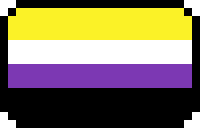
Nonbinary

Table of Contents
- Introduction
- General Information
- Some Common Nonbinary Identities
- Abinary
- Agender
- Androgyne
- Aporagender
- Bigender
- Demiboy/Demiman
- Demigender
- Demigirl/Demiwoman
- Genderfae
- Genderfaun
- Genderflor
- Genderfluid
- Genderflux
- Genderqueer
- Gendervoid
- Graygender
- Maverique
- Multigender
- Neutrois
- Pangender
- Polygender
- Xenogender
- The Nonbinary Flag
- External Links

Introduction
Nonbinary is an umbrella term used to refer to those who do not strictly adhere to the traditional gender binary. As implied by the nature of being an umbrella term, being "nonbinary" is a vast and varied experience. The nonbinary community is quite diverse and full of unique genders and experiences. The nonbinary community has a rich and varied history across the world and throughout indigenous cultures (see third gender for more).
Some nonbinary people use broad, vague labels to define their gender identities. Others seek out precise labels (known as microlabels) to explain their experiences in detail to others. There is a lot of overlap between certain nonbinary identities. Likewise, there are numerous identities which are completely different from one another. Due to the nature of humanity, gender is quite infinite, and humans are constantly inventing new words to describe unique (or thought to be unique) experiences. The internet has streamlined this process, making it easier for nonbinary people to find not only one another, but to discover or coin hyperspecific terms to describe their experiences.
Some nonbinary people present androgynously, while others prefer to lean into their masculinity or femininity. The styles of hair and clothes worn by nonbinary people will vary wildly from person to person, even among those who share the same gender identity. Everyone has their own journey to explore their own personal gender presentation; playing with aesthetics to best communicate their inner selves to the world. To be nonbinary is to find your own unique combination to satistfy the conditions of gender euphoria.
Some nonbinary people use gender neutral pronouns as a method of gender-affirmation, however some still use he or she. Others still use their own unique combinations. They/them pronouns are commonly associated with nonbinary people in the English language, but what pronouns someone uses is all down to personal preference. Not all nonbinary people who share the same gender identity will share the same pronouns. Some nonbinary people will keep the names that they were born with. Others will choose new names to better represent themselves, leaving their deadnames behind.
Finding your identity as a nonbinary person can be freeing. Like any gender journey, to discover that you are nonbinary is to defy gender roles. To defy the unwanted expectations placed upon yourself at birth, and to simply be as you are.
While there are some binary transgender people who try on the nonbinary experience as a stepping stone in their gender transitions; for countless people, to be nonbinary is the destination. The end result. The ideal result. The best case scenario. Most nonbinary people are typically read as either male or female to the general public (who make assumptions about anyone they come across and assume that they must be correct) but the assumptions of others don't have to define who a person is. To be gender diverse is to be yourself, even when things seem against you.
For discrimination against nonbinary people, see binarism. For variations of sexual characteristics that someone can be born with, see intersex. For additional information on terms that you may be unfamilliar with, please utlize the alphabet menu buttons at the top of this page, or click on the underlined words or phrases wherever relevant.

General Information
While the term "nonbinary" is included under the transgender umbrella, not all people who identify as nonbinary also identify as transgender. Many nonbinary people also identify as being transgender. Not all people who identify with a gender identity that may fall under the nonbinary umbrella identify as nonbinary.
Some people who identify as nonbinary will undergo hormonal transition such as taking estrogen or testosterone. Some do not. Some nonbinary people pursue gender affirming surgeries. Some nonbinary people identify with ideas such as nullification or salmacian, and obtain non-traditional gender affirming surgeries accordingly. Some nonbinary people identify under the labels of transfeminine or transmasculine to define their identities. What labels a nonbinary does or does not use is down to the individual person.
Anyone who feels as though they resonate with a nonbinary identity is free to identify as that nonbinary identity. Gender pride flags are used for those who identify as that gender to be able to quickly recognize one another, to find solidarity in one another, to unite communities, and to overall show a shared connection within the same identities.

Some Common Nonbinary Identities
Please note that there are no pronouns that are inherently linked to any particular gender identity. For diversity, various pronouns will be used throughout these different definitions, but the pronouns that are used in a particular section may not be the exact pronouns that every individual person with that gender identity may use. Please note that the experiences of gender dysphoria can vary from person to person. Not all nonbinary people experience it, but hopefully all nonbinary people can achieve the gender euphoria that they seek. Note that while some identities have references to surgery or other forms of transition, that this does not mean that those forms of transition are limited to those gender identities, nor do all people with those particular identities transition in those specific ways.

Abinary

Agender

Androgyne

Aporagender

Bigender

Demiboy

Demigender

Demigirl

Genderfae

Genderfaun

Genderflor

Genderfluid

Genderflux

Genderqueer

Gendervoid

Graygender

Maverique

Multigender

Neutrois

Pangender

Polygender

Xenogender

The Nonbinary Flag
The non-binary flag has four stripes in four colors.
The top yellow stripe represents individuals whose genders do not exist within the traditional gender binary.
The second stripe is white, representing individuals who identify with multiple genders.
The third stripe is purple, representing individuals who identify as a blend of male and female.
The fourth and final stripe is black, represending agender individuals.


External Links
The resources below have been provided for education, information sourcing, and entertainment purposes. The views expressed in these videos, websites, etc, do not inherently reflect those of The Transgender Dictionary. These resources are not sponsored, nor endorsed.

Flag Resources
- Deconforming: Adrien Converse: Gender pride flags and what they mean (https://deconforming.com/gender-pride-flags/) - blog post regarding the flags and meanings for Agender, Androgyne, Bigender, Demiboy, Demigirl, Genderfluid, Genderqueer, Gender questioning, Neutrois, Nonbinary, Transfeminine, Transgender, Transmasculine
- itch.io - 404luxio - tiny pixel pride flags (https://404luxio.itch.io/tiny-pixel-pride-flags) - link to flags used on this page
- My Gender Is X: 07/21/2019: The Ultimate Guide to Non-Binary Gender Identity Flags (https://mygenderisx.com/read/non-binary-gender-identity-flags) - a list of various flags for different nonbinary genders
- OutrightInternational - Flags - LGBTIQ Community (https://outrightinternational.org/insights/flags-lgbtiq-community) - article with a list of queer flags
- Pink News: Jess Glass: 06/04/2024: Every LGBTQ+ flag you might see at Pride and what they all mean (https://www.thepinknews.com/2024/06/04/all-of-the-flags-you-might-see-at-pride-and-what-they-mean/) - article with a list of queer flags
- Pride Flags (https://www.prideflags.org/) - a website dedicated to pride flags
- San Francisco Gay Man's Chorus: 04/17/2023: Get to Know the Meaning Behind the Colors of Major Pride Flags (https://www.sfgmc.org/blog/pride-flags) - blog post of various pride flags and their meanings
- Web Queer Achives - LGBTQIA+ Pride flags (https://web.archive.org/web/20250328121729/https://www.weberqueerarchives.org/copy-of-other-resources) - list of pride flags
- Wikipedia - Non-Binary Flag (https://en.wikipedia.org/wiki/Non-binary_flag) - wikipedia article regarding the nonbinary flag

Additional Resources
- Bustle: Suzannah Weiss: 06/11/2016: These Things Don't Mean You Aren't Non-Binary (https://www.bustle.com/articles/165052-5-things-that-dont-prevent-someone-from-being-non-binary) - article regarding nonbinary misconceptions
- Dictionary: 06/14/2023: Demigender, Maverique, And Gender Terms You May Not Know (https://www.dictionary.com/e/gender-terms-you-may-not-know/) - article regarding some different gender-related terms
- Gender - Fandom - Gender Wiki (https://gender.fandom.com/wiki/Gender_Wiki) - a wiki dedicated to gender
- Healthline: Francis Kuehnle, MSN, RN-BC & Mere Abrams, LCSW & Sian Ferguson: 06/26/2023: Understanding What It Means to Be Nonbinary (https://www.healthline.com/health/transgender/nonbinary)
- Healthline: Francis Kuehnle, MSN, RN-BC & Sian Ferguson & Mere Abrams, LCSW: 68 Terms That Describe Gender Identity and Expression (https://www.healthline.com/health/different-genders) - a list of different gender-related terms
- IndyBay: Mark Gabrish Conlan: 07/17/2011: Red: "Non-Binary" Person Rejects Male/Female Gender Duality (https://www.indybay.org/newsitems/2011/07/17/18685039.php) - an article containing an interview with a nonbinary person discussing their experiences and such relating to being nonbinary
- Making Queer History - Zinaida Gippius (https://www.makingqueerhistory.com/articles/2021/9/30/zinaida-gippius-part-i) - article regarding a russian poet born on November 20, 1869
- NonBinary Wiki (https://nonbinary.wiki/wiki/Main_Page) - official wiki for nonbinary things
- Queer Books For Teens - Generqueer/Nonbinary (https://queerbooksforteens.com/find-books/?fwp_gender=genderqueer-non-binary) - list of books with nonbinary characters
- Reddit - r/NonBinary (https://www.reddit.com/r/NonBinary/) - nonbinary subreddit
- Spanish For Social Change: 05/16/2015: living as a non-binary or gender neutral trans person in Spanish (https://www.spanishforsocialchange.com/2015/05/living-as-non-binary-or-gender-neutral.html) - blog post
- Transgender Map - Gender transition: gender diverse people (https://www.transgendermap.com/welcome/for-trans-people/gender-diverse/) - list of identities and terms largely related to being nonbinary
- Transgender Teen Survival Guide - Nonbinary Flowchart (https://transgenderteensurvivalguide.com/flowchart) - a flow chart to help you figure out if you are nonbinary
- Transgender Teen Survival Guide - Non-binary Resources (https://transgenderteensurvivalguide.com/nonbinaryresources) - a list of resources for nonbinary people
- Trans Language Primer - Genderless (https://translanguageprimer.com/genderless/) - blurb explaining the term genderless
- Trans Language Primer - NB / NBi / Enby (https://translanguageprimer.com/nbi/) - blurb explaining the terms nb, nbi & enby
- Trans Language Primer - Non-Binary (https://translanguageprimer.com/non-binary/) - blurb explaining the term nonbinary
- Wayback Machine: Everyday Feminism: Riley J. Dennis: 06/16/2015: Think You’ve Got ‘Trans’ Down, But Still Feel Confused About ‘Non-Binary?’ Here’s the 101 You’ve Been Looking For (https://web.archive.org/web/20230409000312/https://everydayfeminism.com/2015/06/non-binary-101/) - click on "Click for the Transcript" to read this (video does not work)
- Wayback Machine - Gender Inbetween (https://web.archive.org/web/20150922233213/https://machine.fm/genderinbetween) - An ongoing project documenting the personal histories and stories of individuals living both within and outside of the gender binary.
- YouTube Playlist - 1989 - An Interview with intersex and nonbinary people - videos of a tv interview from 1989

